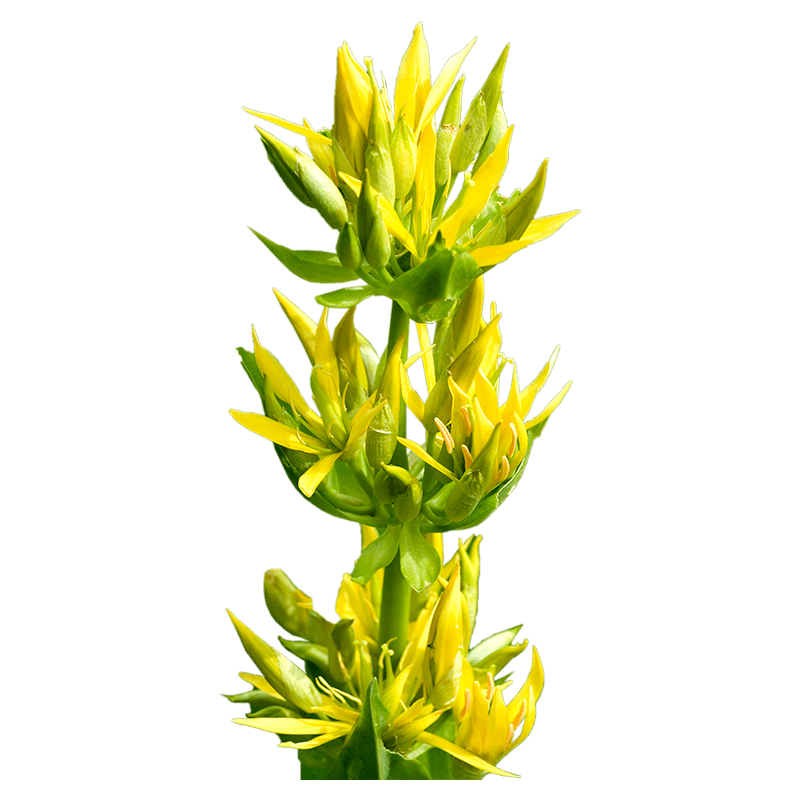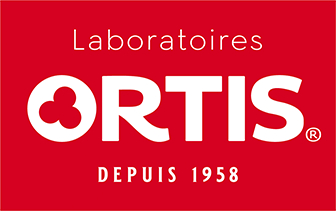
Great yellow gentian
Latin name
Origin
Used part
Active components
Secoiridoids (amarogentin, sweroside): these substances are responsible for the bitterness. They stimulate the production of gastric juices via the vagus nerve and, consequently, have a stimulant effect on the digestion. They protect the liver against the aggression of toxins.
Alkaloids (gentiannine, gentianidine): a bitter flavour, anti-inflammatory and calming action.
Flavonoids (isovitexin): antioxidant and calming action.
Usage
Bibliographical references
- Community herbal monograph on Gentiana lutea l., Radix
Committee On Herbal Medicinal Products (Hmpc)
Doc. Ref.: EMA/HMPC/578324/2008
EMEA: http://www.emea.europa.eu/docs/en_GB/document_library/Herbal_-_Community_herbal_monograph/2010/03/WC500075295.pdf - Smooth muscle relaxing activity of gentiopicroside isolated from Gentiana spathacea.
Rojas A, Bah M, Rojas JI, Gutiérrez DM.
Planta Med. 2000 Dec;66(8):765-7.
Pubmed: http://www.ncbi.nlm.nih.gov/pubmed/11199140 - Phytochemicals of Gentianaceae: A Review of Pharmacological Properties
Amritpal Singh
Herbal division, Ind-Swift Ltd, Chandigar, India.
Pharma Book Syndicate: http://www.pharmabooksyndicate.com/issues/33.pdf - Bitterness values for traditional tonic plants of southern Africa.
Olivier DK, van Wyk BE.
J Ethnopharmacol. 2013 Jun 3;147(3):676-9.
Pubmed: http://www.ncbi.nlm.nih.gov/pubmed/23545459 - Antimicrobial activity of Gentiana lutea L. extracts.
Savikin K, Menković N, Zdunić G, Stević T, Radanović D, Janković T.
Z Naturforsch C. 2009 May-Jun;64(5-6):339-42.
Pubmed: http://www.ncbi.nlm.nih.gov/pubmed/19678535 - Quantitative analysis of iridoids, secoiridoids, xanthones and xanthone glycosides in Gentiana lutea L. roots by RP-HPLC and LC-MS.
Aberham A, Schwaiger S, Stuppner H, Ganzera M.
J Pharm Biomed Anal. 2007 Nov 5;45(3):437-42.
Pubmed: http://www.ncbi.nlm.nih.gov/pubmed/17697760 - Free radical scavenging activities of yellow gentian (Gentiana lutea L.) measured by electron spin resonance.
Kusar A, Zupancic A, Sentjurc M, Baricevic D.
Hum Exp Toxicol. 2006 Oct;25(10):599-604.
Pubmed: http://www.ncbi.nlm.nih.gov/pubmed/17165626 - In vitro susceptibility of Helicobacter pylori to botanical extracts used traditionally for the treatment of gastrointestinal disorders.
Mahady GB, Pendland SL, Stoia A, Hamill FA, Fabricant D, Dietz BM, Chadwick LR.
Phytother Res. 2005 Nov;19(11):988-91.
Pubmed: http://www.ncbi.nlm.nih.gov/pubmed/16317658 - Choleretic activity of Gentiana lutea ssp. symphyandra in rats.
Oztürk N, Herekman-Demir T, Oztürk Y, Bozan B, Başer KH.
Phytomedicine. 1998 Aug;5(4):283-8.
Pubmed: http://www.ncbi.nlm.nih.gov/pubmed/23195900 - Chemical profile, radical scavenging and cytotoxic activity of yellow gentian leaves (Genitaneae luteaefolium) grown in northern regions of Montenegro.
Balijagić J, Janković T, Zdunić G, Bosković J, Savikin K, Godevac D, Stanojković T, Jovancević M, Menković N.
Nat Prod Commun. 2012 Nov;7(11):1487-90.
Pubmed: http://www.ncbi.nlm.nih.gov/pubmed/23285813 - Effects of Gentiana lutea ssp. symphyandra on the central nervous system in mice.
Oztürk N, Başer KH, Aydin S, Oztürk Y, Caliş I.
Phytother Res. 2002 Nov;16(7):627-31.
Pubmed: http://www.ncbi.nlm.nih.gov/pubmed/12410542
The health claims that feature on our website in relation to the plants contained in our products are compliant with the list of health claims awaiting final assessment by the Community authorities (cf. website of the European Commission: http://ec.europa.eu/nuhclaims/). However, they may be subject to modification following their assessment by the national competent authorities.
The health claims relating to other nutrients or substances contained in our products that feature on our site are compliant with Regulation No. 432/2012 of the Commission of 16 May 2012 which establishes a list of authorised health claims authorised in relation to food products, other than those in reference to the reduction of the risk of disease as well as community-based development and child health (cf. website of the European Commission: http://ec.europa.eu/nuhclaims/).

 Belgique
Belgique  België
België  France
France  Italia
Italia  Portugal
Portugal  España
España  United Kingdom
United Kingdom  Κύπρος
Κύπρος 